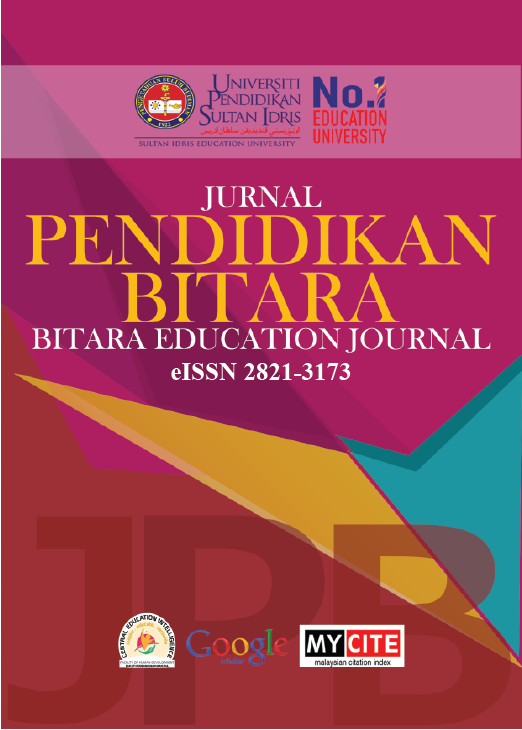Buli siber dalam kalangan murid sekolah menengah di daerah Samarahan, Sarawak
DOI:
https://doi.org/10.37134/bitara.vol13.2.4.2020Keywords:
Buli Siber, Kemurungan, Kebimbangan, TekananAbstract
Kajian ini bertujuan mengenal pasti ciri-ciri buli siber dalam kalangan murid di Daerah Samarahan,Sarawak Tujuh jenis buli siber dalam kajian ini ialah buli siber melalui mesej teks, gambar atau klip video, panggilan telefon, email, bilik smebang, mesej segera dan laman web. Data diperoleh melalui pensampelan bertujuan melibatkan 322 orang murid tingkatan empat di semua sekolah menengah di Daerah Samarahan, Sarawak. Rekabentuk kajian tinjauan menggunakan soal selidik Cyberbullying Questionnaire (CBQ). Data dianalisis menggunakan Statistical Package for Social Sciences (IBM-SPSS) versi ke-23. Keputusan kajian menunjukkan lebih separuh daripada responden pernah menjadi mangsa buli siber iaitu 61.8% (n = 199) berbanding yang tidak dibuli sebanyak 38.2% (n = 123). Dapatan kajian turut mengemukakan ciri-ciri buli siber bagi pemahaman yang lebih kukuh. KKajian ini mencadangkan pihak sekolah, ibu bapa, guru dan rakan sebaya agar memahami ciri-ciri buli siber yang berlaku dalam kalangan murid.
Downloads
References
Doi; http://doi.org/10.1080/02667363.665356
Ahlfors, R. (2010). Many Sources, One Theme: Analysis of Cyberbullying Prevention and Intervention Website. Journal of Social Science, 6(4), 515-522.
Barlińska, J., Szuster, A., & Winiewski, M. (2013). Cyberbullying among adolescent bystanders: Role of the communication medium, form of violence, and empathy. Journal of Community & Applied Social Psychology, 23(1), 37-51.
Boyd, D., & Marwick, A. (2011). Bullying as true drama - Why cyberbullying rhetoric misses the mark. The New York Times.
Campbell, M., Slee, P., Spears, B., Butler, D., & Kift, S. (2013). Do Cyberbullies Suffer Too? Cyberbullies’ Perceptions of the Harm They Cause to Others and to their Own Mental Health. School Psychology International, 34, 613–629.
doi: http://doi.org/10.1177/0143034313479698
Campbell, M., Spears, B., Slee, P., Butler, D., & Kift, S. (2012a). Emotional and Behavioural Difficulties Victims ’ perceptions of traditional and cyberbullying , and the psychosocial correlates of their victimisation, (January 2014), 37–41.
Couvillon, M. a., & Ilieva, V. (2011). Recommended Practices: A Review of Schoolwide Preventative Programs and Strategies on Cyberbullying. Preventing School Failure: Alternative Education for Children and Youth, 55(2), 96–101.
http://doi.org/10.1080/1045988X.2011.539461
Donegan, R. (2012) Bullying and Cyberbullying: History, Statistics, Law, Prevention and Analysis. Journal of Undergraduate Research in Communications, 3(1), 33-42.
Fenaughty, J. & Hare, N. (2013) Factors Associated with Young People’s Successful Resolution of Distressing Electronic Harassment. Computers & Education, 61, str. 242–250.
Grube, B. (2012). Social Media’s Influence on Youth. YDI Research Brief Number 17. Ydi. tamu .edu/wp.../YDI-RB-17-Social-Medias-Influence-on-Youth.pdf 7 Disember 17.
Internet Users Survey,2017. Malaysian Communications and Multimedia Commission (MCMC), MCMC Tower 1, Jalan Impact, Cyber 6 63000 Cyberjaya, Selangor Darul Ehsan
Internet World Stats. (July 1,2016). Malaysia Internet Users (*2016). Diakses dari http://www.internetlivestats.com/internet-users/malaysia/
Mokhlis, S. (2019). Buli Siber Dalam Kalangan Pelajar Sekolah Menengah: Satu Penerokaan Awal. Jurnal Dunia Pendidikan, 1(2), 7-18.
Noh, C. H. C., & Ibrahim, M. Y. (2014). Kajian penerokaan buli siber dalam kalangan pelajar UMT. Procedia-Social and Behavioral Sciences, 134, 323-329.
Pitchan, M. A., Omar, S. Z., & Ghazali, A. H. A. (2019). Amalan Keselamatan Siber Pengguna Internet terhadap Buli Siber, Pornografi, E-Mel Phishing & Pembelian dalam Talian. Jurnal Komunikasi: Malaysian Journal of Communication, 35(3).
Tokunaga, R. S. (2010). Following you home from school: A critical review and synthesis of research on cyberbullying victimization. Computers in Human Behavior.
http://doi.org/10.1016/j.chb.2009.11.014





